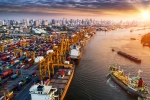
Securing the non-oil recovery
Moving beyond COVID-19
The pandemic caused a sharp contraction in the GCC’s non-oil economy in 2020, which the IMF estimates at -4% y/y in real terms and as much as -12% in Dubai.
However, the region quickly recovered overall as strong secular growth in various sectors offset continued weakness in others. Saudi Arabia led the rebound, matching its 2019 non-oil GDP level as early as Q1 2021 and most of the region hit similar recovery milestones later that year. By the end of 2022, the IMF estimates that total GCC non-oil GDP was 4.8% higher than in 2019, with only Kuwait lagging slightly (it has not published any GDP data since 2020). Saudi Arabia continued to lead, with Q4-22 GDP 11% higher than in Q4-19.
Dubai’s most recent data is from Q3-22 when its non-oil GDP was still -4.5% below the equivalent quarter in 2019. However, leading indicators point to continued strong growth in the emirate since then, including an average PMI of 55 in October to March. In February 2023, Dubai’s tourist arrivals hit a new record for the month, 8% above the 2019 level. Conver

The hardest-hit sectors are recovering
The sectors that were hardest hit in the region during 2020 were the same as experienced globally, including hospitality, transportation and retail/wholesale trade. Hospitality declined by nearly a third, transportation by a sixth and trade by nearly a tenth (not all states disaggregate these sectors, so we don’t have precise figures). These sectors are all partly driven by domestic demand and partly by tourism. The dip in domestic demand was largely temporary, with tourism slower to recover, but the gap has been closing quickly. In 2022, the five states for which regular tourism data is available, lagged 2019 levels by -8%. However, by Q4, three of the five were well above Q4-19. Although Qatar’s surge was a temporary boost from the World Cup, its monthly numbers have remained solid in early 2023.
The increase in the KSA to a quarterly record of 6m tourists in Q4, 47% above the same quarter in 2019, is particularly significant. There is a pent-up demand for pilgrimage as a result of COVID-19 barriers in recent years. There was a significant increase in foreign pilgrims performing Umrah during Ramadan and the Hajj season in June may finally surpass pre-pandemic levels. And when combined with a surge in non-religious tourism, as a result of the easier availability of visas and the development of attractions such as the popular Riyadh Seasons festival, the Kingdom aims to reach 25m tourists this year - 43% more than in 2019.
Domestic trade has seen the strongest recovery as recycled oil revenues have boosted household purchasing power and encouraged business investment. Of the states that have published 2022 data, only Bahrain slightly lagged its 2019 level.
Transportation and hospitality have also shown good signs of recovery in most countries. The exception is Bahrain, where hospitality was still -31% below the 2019 level which is surprising given the strong rebound in visitor arrivals.


Contact us


Richard Boxshall
Global Economics Leader and Middle East Chief Economist, PwC Middle East
Tel: +971 (0)4 304 3100








